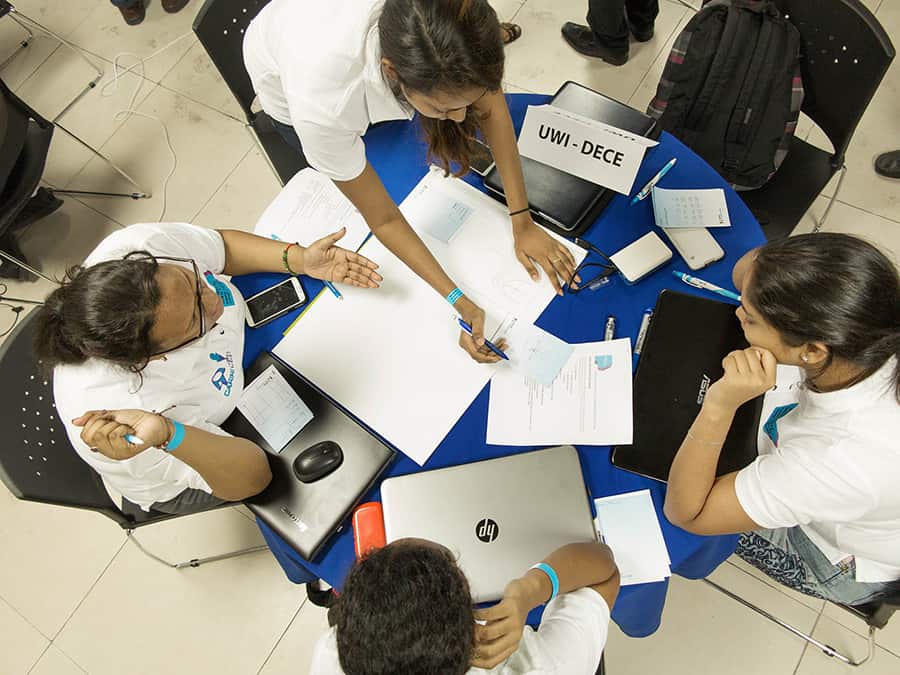
Above: Students of the UWI Department of Electrical and Computer Engineering begin mapping their environmental awareness solution at the inaugural Girls in ICT Day Hackathon. Photo by Mark Lyndersay.
BitDepth#1091 for May 02, 2017
There’s something heartening about seeing a room full of young women, a twinkle in their eyes and a grim set to their jawlines in vigorous competition to create digital solutions to social challenges.
Last Thursday at the inaugural Girls in ICT Day Hackathon, convened locally at CARIRI’s Centre for Enterprise Development in Freeport, dozens of young women considered local problems from a digital perspective.
The event, less an exercise in coding than a day of free-form problem solving enabled by technology was held simultaneously in Jamaica, Trinidad and Barbados and was underwritten by headline sponsors ScotiaBank and the National Commercial Bank of Jamaica. Local sponsors included Loop News, CARIRI and the University of the West Indies.
Six teams each with a maximum of five participants (SBCS showed up with three), coached but not directed by a teacher and independent mentors, competed for four prizes from the event, which challenged them to develop projects that addressed the following subjects; crime and violence (domestic violence, sexual assault or child abuse), drug abuse, cyber-bullying, agricultural sustainability, environmental protection.
Participants included teams from the UWI-DECE labs, SBCS, COSTATT, UTT, Holy Name Convent, and Chaguanas North Secondary School competing in separate secondary and tertiary categories.
Overwhelmingly, the groups chose to focus on hot button issues of crime and bullying, and three young students from Chaguanas North Secondary admitted during a short break that cyberbullying was close to their understanding and experience.
The enormity of the projects and short time demanded significant focus. The first hour was given to development of the idea, with five hours allocated to creation of the solution. The final concept of each team had to be emailed to the Challenge Master, Andy Duncan by midday.
At the end of the event, participants were expected to deliver a pitch to the judges of the event, with separate prizes being given to the best tertiary and secondary teams and the best “hackers” from each school level.
While the actual pitch only accounted for 15 per cent of the overall team score, it offered an opportunity to explain and position the project, reinforcing and guiding marking for concept (30 per cent), innovation and feasibility (35 and 15 per cent respectively).

Students of Chaguanas North Secondary with mentors and their teacher work on their project during the inaugural Girls in ICT Day Hackathon. Photo by Mark Lyndersay. Click to enlarge.
Challenge Master Duncan made announcements several times to guide the process as the young women worked feverishly, notably reminding teams of the importance of focusing more on the planning and concept of their solutions and less on the coding and design of a final prototype. That particular announcement led to a significant hush in the room as approaches were quickly recalibrated at every table.
This was, he explained, the most important objective of the exercise, the encouragement of problem analysis and effective solutions over gorgeous apps and website sleekness.
That didn’t stop students from exploring digital options with enthusiasm. As I peered over the shoulders of students I saw projects being assembled using online tools like AppShed, Glogster and Brackets as ideas were hammered roughly into clickable concepts.
At least one team wisely decided to forgo hard coding for wireframe prototyping as time ran out, and the importance of concept took precedence.
Duncan was pleased with the progress of the event by midday.
“You hear hackathon and the first instinct is coding. Just code, code, code, but a key part of the exercise is to encourage a logical approach to solving the problems they have chosen.”
“I’m seeing good division of labour, though the teams without teachers seem to be bringing more innovation to their approaches.”
Duncan, who has a degree in programming, but is adamant that he isn’t a programmer, argues that, “We can use ICT to solve almost everyday problem, and programming skills give you an unique oversight in applying logic to digital solutions.”
The final presentations, judged by Kyle DeFrietas, Shivani Rampersad and Roger Chung were barebones prototypes and mock ups but the best presentations demonstrated a strong underpinning of conceptual thinking.
The judges were robust in their questioning of the teams, examining process and purpose over execution and the winning teams were those who had clearly thought their approaches through.
The Animae Caribe team from UTT, for instance, presented last but was clearly a winner, playing to their strengths in animation and offering a storyboard and animatic about a hilarious smartphone, Smarty, who takes performance enhancers to remain useful to his user (resonant irony there) only to end up useless and error prone.
Results
Winning individuals, winning a Samsung S6 Edge Plus from Digicel, Giovanna DeSouza: Holy Name Convent and Vicky Harripersad, SBCS.
Winning teams, Chaguanas North Secondary, winning a year’s free Fibre Broadband from Digicel Play and a pair of Digicel IMAX tickets each and UTT – Animae Caribe, each team member receiving a Samsung VR (Virtual Reality) headset.


